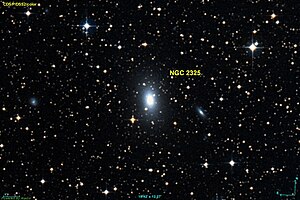NGC 2325
| Galaxy NGC 2325 |
|
|---|---|

|
|
| AladinLite | |
| Constellation | Big dog |
|
Position equinox : J2000.0 , epoch : J2000.0 |
|
| Right ascension | 07 h 02 m 40.4 s |
| declination | -28 ° 41 ′ 50 ″ |
| Appearance | |
| Morphological type | E4 |
| Brightness (visual) | 11.0 mag |
| Brightness (B-band) | 12.0 mag |
| Angular expansion | 3.0 ′ × 1.5 ′ |
| Position angle | 6 ° |
| Surface brightness | 12.7 mag / arcmin² |
| Physical data | |
| Redshift | 0.007288 ± 0.000073 |
| Radial velocity | (2185 ± 22) km / s |
|
Stroke distance v rad / H 0 |
(88 ± 6) · 10 6 ly (27.1 ± 1.9) Mpc |
| history | |
| discovery | John Herschel |
| Discovery date | February 1, 1837 |
| Catalog names | |
| NGC 2325 • PGC 20047 • ESO 427-028 • MCG -05-17-005 • 2MASX J07024038-2841501 • LDCE 0483 NED024 | |
NGC 2325 is an elliptical galaxy of Hubble type E4 in the constellation Canis Major in the southern sky . It is estimated to be 88 million light years from the Milky Way .
The object was discovered by John Herschel on February 1, 1837 .
